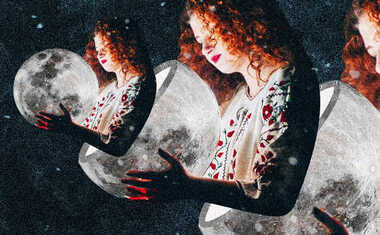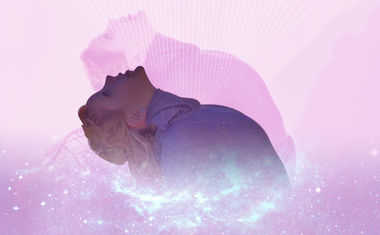
Representation Matters: Creating the Melanated Classic Tarot
Discover how this deck is bringing inclusivity to the Tarot world
The creation of the Melanated Classic Tarot began years ago, via my love affair with Astrology, because I'm impatient, nosy, and I loathe suspense. In high school, I would find out the birthdays of the boys I liked and then stalk their horoscopes to see if they liked me back. My obsession with knowing what will happen before it happens led to rabbit holes of online natal charts and compatibility calculators, despite the awkwardness of asking a beloved's birth time.
These episodes would come and go depending on my relationship status, but slowly over the years, regardless of requited or unrequited love, the science of Astrology began to color the shape of my life. Suddenly, I could link every emotion to a moon phase and every electronic malfunction and communication misfire with Mercury Retrograde. Advice to friends and family became peppered with anecdotes of the sky: "Don't change your hairstyle until Venus goes direct, trust me."
And then, in my mid-thirties, faced with problems that even Astrology could not solve, I turned desperately to Tarot in hopes of being able to see ahead of the curve. Abundant in questions but lacking cash, I took advantage of the thousands of free Tarot readings graciously offered on YouTube. Some readings resonated and some didn't, but my curiosity was piqued despite the accuracy. Not long after, I became determined to get my own deck and learn Tarot for myself.
About the Tarot cards
My first Tarot deck -- as is the case for most people -- was the Rider-Waite-Smith (most commonly referred to as the Rider-Waite), the most well-known and time-honored deck currently in print. A little history: The deck was commissioned in 1909 by Arthur Waite and illustrated by Pamela Colman Smith, and it has been the industry standard Tarot deck for the last 111 years. It is something of a "master deck," the template from which most other decks, including the Melanated Classic Tarot, are formed.
The Rider-Waite-Smith deck has of a total of 78 cards or scenes, divided into what is known as the Major Arcana and Minor Arcana. The Major Arcana consists of 22 cards that use images of people, angels, and other magical creatures to represent each of the ten planets and each of the twelve astrological signs. This is the depiction of the entire heavens, known as "as above."
The remaining 56 cards are called the Minor Arcana. They are broken down into four suits that represent the four elements: Wands (Fire), Cups (Water), Swords (Air), and Pentacles (Earth). Almost each card in the Minor Arcana features people in various scenes depicting everyday life, meant to represent either a combination of one planet and one astrological sign (numbers Two through Ten), the raw power of a specific element (Aces), or a person whose personality traits embody a combination of two elements (Court cards). Therefore, the Minor Arcana is an all-encompassing mirror, reflecting the movement of the heavenly bodies and how that movement influences the people and energy of the earth. This is known as "so below."
How inspiration struck
But I didn't know any of that at first. From readings on YouTube, I knew that some of the cards had to do with astrological signs, but aside from the small booklet that offered a series of disjointed definitions for each card, I was clueless. It was like expecting to drive a newly purchased car off the lot and instead being handed a steering wheel and various boxes of machinery. In an attempt to put it all together, I remember spreading all 78 cards out on my bed and focusing intently at each one, determined to find the story.
I have an MFA in Creative Writing, but my love affair with stories began in childhood, with pictures. It is the need to ponder and process images that intrigues us into speech. There is a ton of life and electric energy in each scene of the Tarot, but when I excitedly tried to put a narrative together, I became uncomfortable. I felt like an outsider getting into their business. I don't know how to explain it other than it was like rushing through a door because you hear voices, but when you step into the room, everyone goes silent and remains silent until you leave.
It was then that I felt the spirit of my late grandmother utter the truth that became the driving force behind the creation of the Melanated Classic Tarot: "You need to color them brown. If they were brown, they would talk to you." I was a little dismayed, but it made sense, as we're more likely to spill our guts to kinfolk than to strangers. Just because I had bought the cards and brought them home didn't mean we knew each other. The language of spirit is connection, so how can you resonate if you don't relate?
The beginning of the Melanated Classic Tarot
My grandmother, the daughter of sharecroppers and granddaughter of slaves, was born in Alabama in 1920. She lived through two World Wars, the Great Depression, the Civil Rights Movement, and a plethora of personal mountain-highs and valley-lows. She knew a thing or two about a thing or two. She only had a 6th grade education, but despite her limited classroom learning, taught me one of life's most important lessons by virtue of her example: representation matters.
It was this lesson that came back to me as I pondered the Tarot. I remembered that as a child, my grandma always had a tough time finding proper birthday cards for me, ones that depicted little brown girls. Not to be deterred, she would purchase the birthday card with a little white girl on it and would then color in her face, hands, arms, and legs with a dark brown crayon. My grandmother knew intuitively that self-esteem and security is directly tied to visibility, and she wanted to make sure I could see myself in this world.
It was this precedent of visual rebellion that planted the seed of the Melanated Classic Tarot. Once I understood I was craving brown cards, I spent a few weeks searching for decks that featured people of African descent, but the symbolism was notably different. The decks I looked at featured people of the diaspora, but to a beginner like myself, the symbolism was alternate, impenetrable, and advanced. Eventually I realized that what I really wanted was a beginner's deck that exactly like the Rider-Waite-Smith deck, only featuring brown people so I wouldn't feel shut out of the conversation.
I accepted I'd have to create the deck I wanted because it didn't exist anywhere. I casually mentioned the idea to my partner at the time, and he suggested Julia Goolsby as an artist, as he was already familiar and enamored with her amazing body of work. He introduced us and the rest is her-story. The crazy thing is that my grandmother's name is also Julia, and Julia, the artist of the Melanated Classic Tarot, told me toward the end of the project that she was named after her grandmother, also named Julia. It was kismet, serendipity, synchronicity.
A more inclusive Tarot deck
It was during my research while preparing to write the booklet for the Melanated Classic Tarot that I stumbled across the fact that Pamela Colman Smith, the original artist for the Rider-Waite-Smith deck was bi-racial, with family roots in Jamaica. This discovery eased any lingering doubts I had about taking a "White" deck and making it "Black." I realized I wasn't inserting blackness where it didn't belong; I was actually reclaiming a space where blackness already existed and had been silenced and marginalized.
I can only imagine what it must have felt like for Colman Smith to live such a colorful and diverse existence, only to be memorialized for depicting the whole of the cosmos through Tarot with a pale, monotone brush. I'd like to think that Julia and I have Colman Smith's blessing in reimagining the images of the deck into the Melanated Classic Tarot. For us, it was an opportunity to present a more realistic interpretation of the countenances that she might have considered magical archetypes.
Since its release in 2018, word about the Melanated Classic Tarot deck has spread like wildfire. The response and support has been phenomenal and beyond my and Julia's wildest dreams. I continue to remind myself -- when I am not pinching myself -- that no matter what happens next on this incredible ride, I accomplished what I set out to do, which was to create the deck I wanted.
I can also hear my cards perfectly now, and they say, "THANK YOU!"
To learn more about Oubria and the Melanated Classic Tarot, you can visit her website.



